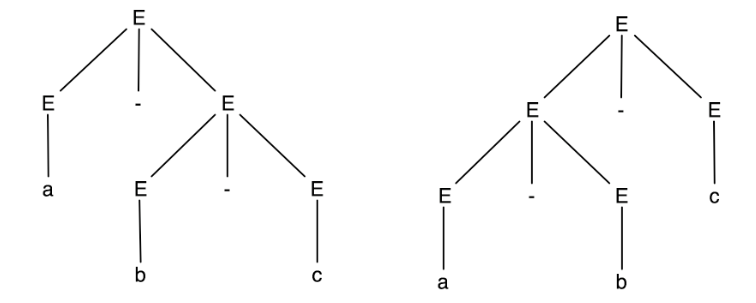CMSC330
Grammars
Grammars
Compilers/Interpreters
Compilers/Interpreters
Compiler: convert from language to machine code
Practically: convert from language to assembly
Abstracted: convert from language to another
Abstracted: convert from language to another
Three things we need for a translator
- Lexer
- Parser
- Evaluator/Generator
Abstracted: convert from language to another
Three things we need for a translator
- Lexer
- Typically uses RE to convert text file to a list of tokens (word types)
- Parser
- Evaluator/Generator
Abstracted: convert from language to another
Three things we need for a translator
- Lexer
- Typically uses RE to convert text file to a list of tokens (word tpyes)
- Parser
- Converts Tokens to an Abstract Syntax Tree using a Context Free Grammar (CFG)
- Evaluator/Generator
Abstracted: convert from language to another
Three things we need for a translator
- Lexer
- Typically uses RE to convert text file to a list of tokens (word tpyes)
- Parser
- Converts Tokens to an Abstract Syntax Tree using a Context Free Grammar (CFG)
- Evaluator/Generator
- Converts AST to Target or evaluates to value
Grammars
RE: describes a set of strings
CFGs: describes a set of strings but more of them
Grammar: structure of a langauge
We already saw a CFG
\(\begin{array}{rl} R \rightarrow & \emptyset\\ & \vert \epsilon\\ & \vert \sigma \\ & \vert R_1R_2\\ & \vert R_1\vert R_2\\ & \vert R_1^*\\ \end{array} \)
\(\begin{array}{rl} R \rightarrow & \emptyset\\ & \vert \epsilon\\ & \vert \sigma \\ & \vert R_1R_2\\ & \vert R_1\vert R_2\\ & \vert R_1^*\\ \end{array} \)
Things we need for a CFG
- \(\sum\): Alphabet (known as terminals)
- Non-Terminals: Denotes groups of terminals
- Productions: Says what symbols can replace others
- Start Symbol: where to start
Things we need for a CFG
- \(\sum\): Alphabet (known as terminals)
- Non-Terminals: Denotes groups of terminals
- Productions: Says what symbols can replace others
- Start Symbol: where to start
Consider the simple grammar for /[01]+/
Consider the simple grammar for /[01]+/
\(S \rightarrow 0S \vert 1S \vert 1 \vert 0\)
If I want to generate the string "001"
\(S \Rightarrow 0S\)
\(0S \Rightarrow 00S\)
\(00S \Rightarrow 001\)
This process is called deriving
Designing Grammars
Recursion allows for repetition
\(S \Rightarrow 0S\vert \epsilon\)
Designing Grammars
Seperate Non-terminals can be used for concatenation
\(S \rightarrow AB\)
\(A \rightarrow hello\)
\(B \rightarrow world\)
Designing Grammars
Unlike Regex, we can refer backwards
Start at middle of string and build outward
Notation: \(a^nb^n\)
\(S \rightarrow aSb\vert \epsilon\)
Designing Grammars
Each path in a union can be a Non-terminal
(c|k)l(i|y)(ff|ph)
\(S \rightarrow AlBC\)
\(A \rightarrow c|k\)
\(B \rightarrow i|y\)
\(C \rightarrow ff|ph\)
Parse Trees and ASTs
Recall: Grammar describes structure of a langauge
We can model this structure with a Tree

Recall: Grammar describes structure of a langauge
We can model this structure with a Tree

Recall: Grammar describes structure of a langauge
We can model this structure with a Tree

Recall: Grammar describes structure of a langauge
We can model this structure with a Tree

Recall: Grammar describes structure of a langauge
We can model this structure with a Tree

Recall: Grammar describes structure of a langauge
We can model this structure with a Tree

Recall: Grammar describes structure of a langauge
We can model this structure with a Tree







Sometimes multipe trees exist
Conisder the following grammar
\(E \rightarrow A\vert E + E\vert E - E\vert E * E\vert E / E\vert (E)\)
\(A \rightarrow 0\vert 1\vert \dots\vert 9\vert a\vert b\vert \dots \vert z\)
Consider: a - b - c
Consider: a - b - c

There are left and right derivations
Sometimes, left derivations have multiple deriviations
This is called ambiguity (which is bad)
Two ways to fix ambiguous grammars
- Rewrite the Grammar
- Different Parsers have different rules
Two ways to fix ambiguous grammars
- Rewrite the Grammar
- Ultimately many different ways to describe a set of strings
- Different Parsers have different rules
\(E \rightarrow A\vert E + E\vert E - E\vert E * E\vert E / E\vert (E)\)
\(A \rightarrow 0\vert 1\vert \dots\vert 9\)
Can rewrite the grammar to
\(E \rightarrow A \vert A + E\vert A - E\vert A * E\vert A / E\)
\(A \rightarrow 0\vert 1\vert \dots\vert 9\vert (E)\)
No longer Ambiguous, but one problem remains
No longer Ambiguous, but one problem remains
What about precedence?
Parse Trees follow Non-terminals: so add more
\(E \rightarrow A + E\vert A - E\vert A\)
\(A \rightarrow B * A\vert B / A\vert B\)
\(B \rightarrow 0\vert 1\vert \dots\vert 9\vert (E)\)
Dangling Else Problem
\(\begin{array}{rl} S \rightarrow & if\ S\ then\ S\\ S \rightarrow & if\ S\ then\ S\ else\ S\\ S \rightarrow & V\\ V \rightarrow & true \vert false\\ \end{array} \)
if true then false else true
if true then if false then true else false
What else do we know that does this?
CFGs can describe programming languages
Will be the basis for parsers
An Abstract Syntax Tree (AST) is the backend data structure parsers use
Basically: parse trees show how things should be parsed
Basically: ASTs are the abstraction of a parse tree